盐渍化灌区玉米施氮量阈值DNDC模型模拟
2021-03-17戴嘉璐李瑞平李聪聪鲁耀泽华智敏
戴嘉璐,李瑞平※,李聪聪,鲁耀泽,华智敏
盐渍化灌区玉米施氮量阈值DNDC模型模拟
戴嘉璐1,李瑞平1※,李聪聪1,鲁耀泽2,华智敏3
(1. 内蒙古农业大学水利与土木建筑工程学院,呼和浩特 010018;2. 巴彦淖尔市水利科学研究所,巴彦淖尔 015000;3. 内蒙古自治区水利水电勘测设计院,呼和浩特 010020)
为了寻求保障农业生产和环境友好的适宜施氮量,该研究利用内蒙古河套灌区2 a田间试验数据对脱氮-分解作用模型(Denitrification-Decomposition Model,DNDC)进行了率定与验证,模拟并研究了影响硝态氮淋失量和植株吸氮量的关键因素,以及玉米施氮量阈值。结果表明:1)DNDC模型可以较好地模拟玉米产量及氮素吸收利用情况,率定和验证过程中玉米产量、叶面积指数和收获时土壤0~20 cm土层土壤硝态氮累积量纳什效率系数与2均不小于0.75,标准均方根误差为9.26%~21.48%。2)施氮量和追肥次数对硝态氮淋失量和植株吸氮量的影响较大,而耕作深度和灌水量对硝态氮淋失量和植株吸氮量的影响较小。且过多施用氮肥不会促进植株吸氮量和产量的增加,反而会增加硝态氮淋失量造成环境污染。3)植株吸氮量和玉米产量均随施氮量增加呈先增长后逐渐趋于稳定的趋势。此外,当追肥次数为3次时,生育期植株吸氮量较追肥1次和2次时的植株吸氮量平均高167.18%和31.27%。4)当追肥次数相同时,硝态氮淋失量随施氮量增加而增加;当施氮量相同时,随追肥次数增加,硝态氮淋失量逐渐降低。当追肥次数为2次和3次时,生长季硝态氮淋失量较追肥1次时平均减少41.96%、59.75%。综合考虑玉米产量、硝态氮淋失量和植株吸氮量,当施氮量为165.50~200 kg/hm2,且分别在拔节期、抽雄期和灌浆期进行追肥为较优的施肥方案。研究成果可为减少河套灌区地下水环境污染及资源浪费提供技术支撑。
氮;淋失;灌溉;玉米;产量;植株吸氮量;DNDC模型
0 引 言
作为一个发展中国家,越来越大的粮食需求、人口增长和经济发展的压力使中国成为世界上氮肥消耗量最多的国家[1]。例如,在2015年,中国的氮肥施用量高达2 362万t[2],而作物仅利用了土壤中30%~40%的氮素[3],氮肥利用效率处于较低水平。此外,由于施入土壤中的氮素易挥发、淋失,当氮肥施用量过多时不仅会使未被作物吸收利用的氮素运移到深层土壤污染地下水,还会使多余氮素挥发到大气中造成环境污染[4]。内蒙古河套灌区地处中国干旱的西北地区,以往农业生产中常以投入大量氮肥来获得高产[5]。因此,过量施氮成为地下水污染的主要来源[6]。而土壤氮素的淋失以NO3—-N为主要形态,土壤中NO3—-N运移是造成氮素淋失的关键前提条件[7]。而控制硝态氮淋失的关键之一是制定合理的方案使氮素供应在空间和时间上与植物需求更好的同步[8],从而达到减少氮素损失的风险。
长期以来,田间试验成为评价不同管理措施效果的依据[9]。谷少委等[10-11]研究表明,恰当的施肥方式和施肥时机可以有效提高作物产量。张璐等[12-13]研究发现,适当减少氮肥施用量不仅可以获得较高的氮肥利用效率还能保障作物高产稳产。参考文献[14],将施氮量阈值描述为:当施氮量达某一值后,继续增加施氮量时产量变化微小或有所降低,且硝态氮淋失量在可接受范围时对应的施氮量值。
尽管大量田间试验已揭示了施肥量对作物氮周转过程及作物产量的影响,但田间试验由于费时费力,易受时间、资金和条件的限制。基于此,模型模拟已成为农田水肥管理对作物生长、水肥资源利用及环境响应研究的重要手段。脱氮-分解作用模型(Denitrification-Decomp- osition Model,DNDC)的主要功能是对农业生态系统中碳氮动态转化进行模拟[15-17],该模型可以模拟出不同作物及不同灌水和施肥方式与制度下的作物生长状况、土壤环境变化及水氮迁移等指标[18]。由于模型输入参数简单、模拟结果精确等特点,经过几十年的发展,DNDC已经被全球广泛使用,多用于评价管理措施对产量或环境风险的影响。朱波等[19]基于DNDC模型模拟氮素淋失量,结果发现模拟值与实测值的吻合程度较好,相关系数达0.972。Li等[20]利用校验后的DNDC模型很好地模拟了农田土壤氮淋失量。Zhang等[14]基于DNDC模型模拟不同施氮量对玉米产量和硝态氮淋失量的影响,指出玉米产量和硝态氮淋失量均随施氮量增加而增加,得出保障作物一定产量及硝态氮淋失量较低时所对应的最佳施氮量。李仙岳等[21]利用DNDC模型不同情景模拟及线性+平台模型寻优,发现降解地膜覆盖农田施氮肥252.94 kg/hm2为北方干旱区降解地膜覆盖下较优的施肥模式。周慧等[22]通过田间试验和DNDC模型模拟,研究了有机氮替代不同比例无机氮对玉米产量和硝态氮淋失的影响,得出有机无机氮配施比例3∶2为研究区较优有机无机氮配施模式。大量基于DNDC模型的研究已经广泛评估了不同种植系统的氮素损失[23-25],但是从农业生产(产量)及环境角度(氮素淋失量)确定最佳施氮量和施肥方案的研究较少。
为了评价不同施肥方案对内蒙古河套灌区玉米产量、硝态氮淋失量及植株吸氮量的影响,本研究利用河套灌区2 a田间试验数据对DNDC模型进行了率定与验证,评价DNDC模型在内蒙古河套灌区的适用性,并基于DNDC模型模拟不同施肥方案下氮素吸收利用情况,在此基础上,确定在保障玉米一定产量及可接受硝态氮淋失量时的临界施氮量和施肥方案,以期为提高氮肥利用效率以及降低地下水污染提供理论依据。
1 材料与方法
1.1 试验区概况
试验于2019—2020年4—9月在内蒙古自治区巴彦淖尔市临河区的曙光试验站(40°43′26″N,107°13′23″E)进行,试验区属于干旱半干旱气候,平均年降雨量为144.2 mm,年蒸发量为2 434.7 mm,年日照时间为3 180 h。土壤质地为沙壤土,耕层平均容重为1.45 g/cm3,盐分1.2 g/kg,有机质10.80 g/kg,全氮量0.244 g/kg,全磷量0.338 g/kg,地下水埋深在 2.5 m左右。玉米是该地区的主要粮食作物。试验区土壤及气象条件见表1和图1。
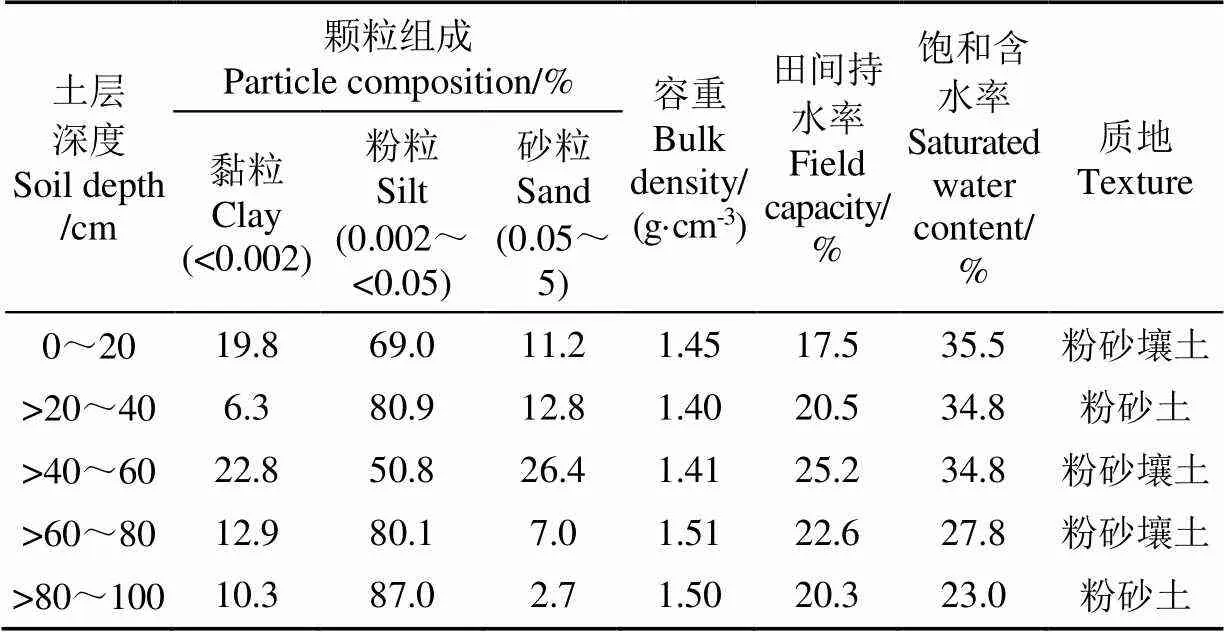
表1 试验区土壤条件
1.2 试验设计
试验设置灌水量和施肥量2个因素,每个因素3个水平。灌水水平分别为低水(180 mm)、中水(225 mm)、高水(270 mm),施肥水平(底肥+追肥)分别为低肥(300 kg/hm2+300 kg/hm2)、中肥(300 kg/hm2+ 375 kg/hm2)、高肥(300 kg/hm2+450 kg/hm2),试验采用完全随机区组设计,将当地一般灌水量(339 mm)和施肥量(300 kg/hm2+ 600 kg/hm2)设为对照CK。每个处理3次重复。各处理底肥均施用300 kg/hm2磷酸二铵,含氮18%,播种时由播种机带入,与当地施肥方式相同;抽雄期追肥,追肥施用尿素,含氮46.8%。各处理总施氮量及具体试验设计见表2。

表2 灌溉与施肥处理
玉米供试品种为“金苹628”,种植密度为行距40 cm,株距30 cm。2 a田间试验具体播种日期分别为2019年4月29日和2020年4月23日,收获日期分别为9月25日和9月12日。灌水方式为地面灌溉,采用水泵、水表定量控制,2019年灌水日期分别为6月17日、7月12日、8月5日,2020年灌水日期分别为6月14日、7月6日、8月3日。各处理均采用相同的田间管理方法进行除草及病虫害防治。
1.3 测定指标与方法
1)叶面积指数:在各生育期定株测量每个小区的叶片长度及宽度。叶面积指数(Leaf Area Index,LAI)采用下式计算[26]:
式中为种植密度,株/hm2;为第株玉米的总叶片数;为测定株数;L为叶片叶领到叶尖的长度,m;B为叶片最宽处宽度,m;0.75为与叶形有关的叶面积回归系数。
2)产量:玉米成熟后在每个小区选取能够代表平均长势的3株成熟玉米,果穗风干后经人工脱粒,75 ℃烘干至恒质量后计算产量。
3)硝态氮含量:用土钻在试验区进行取样,取样深度分别为0~20,>20~40,>40~60,>60~80,>80~100 cm,共5层;每14 d测定1次,每次取土后的土样采用紫外分光光度法测定土壤的硝态氮含量,并计算累积量[27]:
硝态氮累积量(kg/hm2)
=土层厚度(cm)×土壤容重(g/cm3)
×土壤硝态氮含量(mg/kg)/10(2)
1.4 DNDC模型简介
1.4.1 DNDC模型基本原理
DNDC是一个模拟碳、氮在主要生态驱动力作用下生物地球化学循环的模型,该模型主要由两部分构成:1)土壤有机质分解模型、土壤气候模型和作物生长模型,这一部分的主要功能是模拟土壤的环境条件;2)硝化作用模型、脱氮作用模型及发酵作用模型,此部分的主要功能为模拟土壤环境变化对微生物活动的影响。输入该模型的主要参数为气象数据、土壤环境数据和作物管理数据,并以日为时间步长,模拟不同环境条件—作物生长—土壤环境变化间的相互作用。输出数据包括土壤碳氮变化情况、作物生长指标及产量、温室气体挥发量等[28]。DNDC模型用于模拟土壤氮素运移的主要方程见式 (3)~式 (14)。


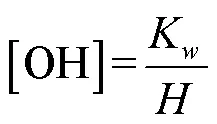






1.4.2 模型评价指标
对模型校验过程中的模拟值和实测值之间的吻合程度采用决定系数(2),标准均方根误差(Norm Root Mean Squared Error,NRMSE)、纳什效率系数(E)来评价。其中,2越接近于1表明模型模拟越准确;若2小于0.5,则可认为模拟效果较差;E取值为−∞<E<1.0,E接近1,表示模拟效果好;E接近0,表示模拟结果较差;E远小于0,则模拟结果不可信。NRMSE≤10%,表明模拟效果极好;10%
1.4.3 模型参数敏感性分析
在不同管理措施下,对校验过的DNDC模型进行敏感性分析,从而找出影响玉米产量、硝态氮淋失量及植株吸氮量的主要因素。该模型在保持所有其他参数不变的情况下,通过在一个适当的范围内改变单个管理参数的值进行模拟。基准情景(情景1)选为Y8处理:耕作深度为20 cm、施氮量为229.50 kg/hm2(底肥施氮量为54 kg/hm2,追肥施氮量为175.50 kg/hm2)、逗肥1次灌水量为270 mm。气象数据、土壤数据和作物数据与2019年试验观测数据一致。总共有9种不同管理方案,并以此计算敏感性指数[30],以评估不同管理措施(耕作、肥料和灌溉)对作物产量、硝态氮淋失量和植株吸氮量的影响。9种管理方案(耕作深度(cm)、施氮量(kg/hm2)、追肥次数、灌水量(mm))如下:
1)情景1:20、229.5、1、270
2)情景2:10、229.5、1、270
3)情景3:30、229.5、1、270
4)情景4:20、179.5、1、270
5)情景5:20、279.5、1、270
6)情景6:20、229.5、2、270
7)情景7:20、229.5、3、270
8)情景8:20、229.5、1、90
9)情景9:20、229.5、1、450
敏感性指数计算公式如下:
式中为敏感性指数;1为与参数1对应的模型输出值;2为与参数2对应的模型输出值;O为1与2的平均值;1为各参数的最小输入值;2为各参数的最大输入值;avg为1与2的平均值。
敏感性指数的绝对值越大,相对应的参数对玉米产量、硝态氮淋失量和植株吸氮量的影响越大。若敏感性指数为负值,表明该参数与玉米产量、硝态氮淋失量或植株吸氮量成负相关。
1.4.4 模型应用
将率定和验证后的模型用于评估不同施氮情况下玉米产量及氮素利用变化情况。为探寻当地适宜的玉米施氮量阈值,设定了8种施氮量,设定依据参考文献[14,21],分别为纯N 100、150、200、250、300、350、400和450 kg/hm2,并考虑了追肥次数的影响[14],设定了3种追肥次数,分别为1次(苗期、拔节期、抽雄期、灌浆期和成熟期)、2次(拔节期和抽雄期、拔节期和灌浆期、抽雄期和灌浆期)、3次(拔节期、抽雄期和灌浆期),共72种模拟情景。多次追肥时的单次肥料用量见表3。
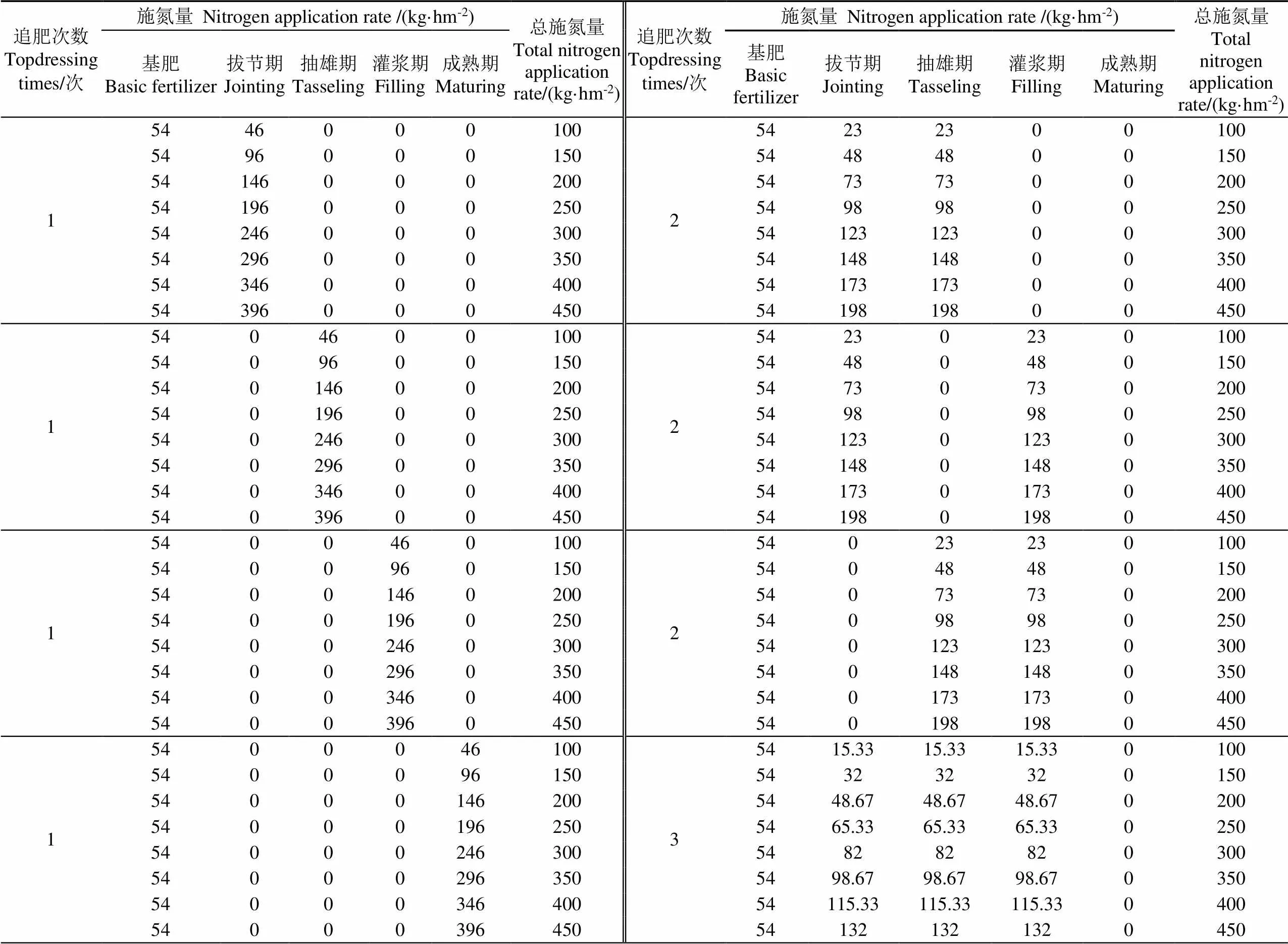
表3 多次追肥时的肥料用量
2 结果与分析
2.1 模型率定与验证
利用2019年试验数据进行率定,以玉米叶面积指数、产量和收获时0~20 cm土层土壤硝态氮累积量为目标,利用模拟值和实测值的吻合程度来确定模型输入参数,最后通过2020年获得的田间数据进行验证。结果表明(图 2),在不同施氮处理下,DNDC模型的模拟效果较好,模型校验过程中玉米叶面积指数、产量和收获时土壤0~20 cm土层土壤硝态氮累积量的模拟值与实测值均分布在1∶1线附近,且三者E与2均不小于0.75,NRMSE分别为13.49%~17.51%、9.26%~9.57%和19.84%~21.48%。率定和验证过程中模型评价指标表明,DNDC模型能较好地模拟不同施氮量对玉米产量及氮素吸收利用的影响,可利用校验后的模型模拟不同施氮情况下玉米产量及氮素利用变化情况。
2.2 模型参数敏感性分析
利用验证过的DNDC模型进行敏感性分析以评估不同输入参数对模拟结果的影响,进而确定影响硝态氮淋失量和植株吸氮量的关键因素。敏感性分析表明(表4),施氮量(敏感性指数1.92、−0.89)和追肥次数(敏感性指数0.11、−0.85)对硝态氮淋失量和植株吸氮量的影响较大,而耕作深度(敏感性指数0.03、0.09)和灌水量(敏感性指数−0.02、−0.01)对硝态氮淋失量和植株吸氮量的影响较小。另外,玉米产量仅对施氮量(敏感性指数−0.48)敏感,且由敏感性指数可知,过多施用氮肥将会对玉米产量产生不利影响。由敏感性分析可知,硝态氮淋失量和植株吸氮量对施氮量和追肥次数最为敏感,因此,施氮量与追肥次数的最佳组合是调节氮流失和玉米生产的有效方法。
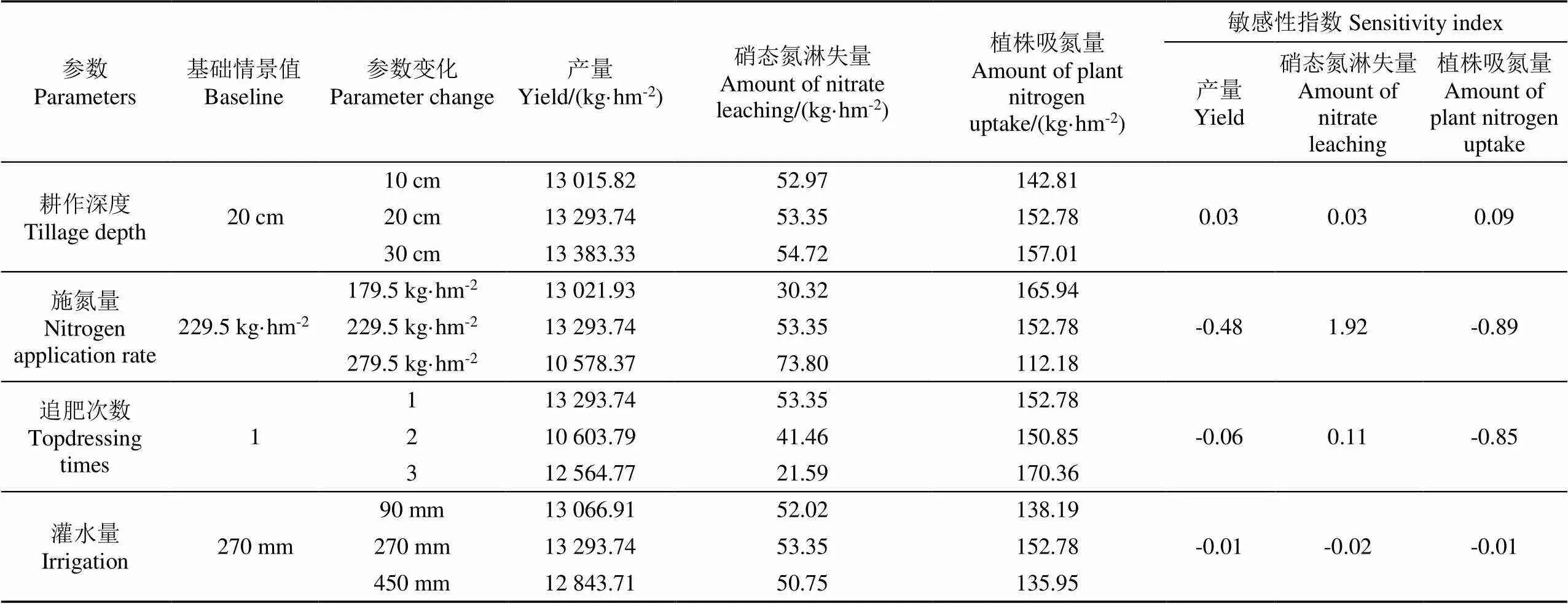
表4 不同参数对玉米产量、硝态氮淋失量及植株吸氮量的影响
2.3 不同管理方案对植株吸氮量和硝态氮淋失量的影响
由图3可知,追肥1次时生育期植株吸氮量随施氮量增加呈先增长后逐渐趋于稳定趋势。苗期和成熟期进行追肥时,各施氮处理下的植株吸氮量较其他生育期追肥时平均降低50.98%和55.37%。原因是苗期植株矮小,生长速度慢,对养分的需求量较少,而成熟期玉米停止生长,各器官也基本不再发生变化,很少吸收养分。
追肥次数为2次和3次时,生育期植株吸氮量随施氮量同样呈先增长后趋于稳定的趋势。图3表明,追肥3次时,各施氮处理下生育期植株吸氮量较追肥1次和2次时的植株吸氮量平均高167.18%、31.27%。
对不同追肥次数下生育期植株吸氮量随施氮量变化采用Logistic方程进行回归分析,由拟合结果可知(表 5),各方程的2在0.974~0.999之间,拟合效果较好。通过对回归方程进行二次求导,得到不同施氮处理和追肥次数下植株吸氮量达最大值时所对应的施氮量。其中追肥3次植株吸氮量达最大值时所对应的施氮量为165.50 kg/hm2。
不同管理方案下生长季硝态氮淋失量均随施氮量增加呈逐渐增长的趋势(图4)而随着追肥次数增加,硝态氮淋失量呈逐渐降低趋势(表6)。当追肥次数为2次和3次时,生长季硝态氮淋失量较追肥1次时平均减少41.96%、59.75%。这主要是由于适当的追肥次数与玉米对氮的需求吻合较好,从而间接降低了玉米生长过程中氮的淋失[31]。
2.4 最佳施氮量和追肥次数确定
本研究基于产量及环境角度利用DNDC模型来确定最佳施氮量和追肥次数,目的是寻求一种既能使玉米获得稳产,又能使硝态氮淋失量控制在可接受水平的临界施氮量和追肥次数。

表5 不同施氮处理和追肥次数下玉米生育期植株吸氮量的Logistic拟合方程
注:为施氮量,kg·hm-2;为植株吸氮量,kg·hm-2。
Note:is the nitrogen application rate, kg·hm-2;is the amount of plant nitrogen uptake, kg·hm-2.
模拟结果表明(图5),玉米产量随施氮量增加呈先快速增长后趋于稳定的趋势。当施氮量小于200 kg/hm2时,玉米产量随施氮量和追肥次数增加而增加;当施氮量增加到200 kg/hm2时,继续增加氮肥对玉米的增产作用逐渐减小,甚至出现减产效果。追肥1次时,当施氮量从100 kg/hm2增加到200 kg/hm2时,产量平均增加52.36%;当施氮量从200 kg/hm2增加到450 kg/hm2时,产量仅增加了1.84%。追肥2次时,当施氮量从100 kg/hm2增加到200 kg/hm2时,产量平均增加111.52%;当施氮量从200 kg/hm2增加到450 kg/hm2时,产量反而降低了1.98%。追肥3次时,当施氮量从100 kg/hm2增加到200 kg/hm2时,产量平均增加131.09%;当施氮量从200 kg/hm2增加到450 kg/hm2时,产量反而降低了1.66%。
为达到GB/T14848—1993《地下水质量标准》中规定的20 mg/L的人类健康标准,玉米生长季硝态氮淋溶量应低于18.4 kg/hm2[14]。由表6可知,追肥1次且施氮量为100 kg/hm2、追肥2次且施氮量在100~150 kg/hm2与追肥3次且施氮量在100~200 kg/hm2时,硝态氮淋失量均在可接受范围。由图5可知,追肥1次且施氮量为100 kg/hm2与追肥2次施氮量在100~150 kg/hm2时,玉米产量较低,平均产量仅有5 414.93 kg/hm2。由前文分析可知(表5),追肥3次植株吸氮量达最大值时所对应的施氮量为165.50 kg/hm2,因此,综合玉米产量及氮素吸收利用情况,最佳施氮量范围为165.50~200 kg/hm2。
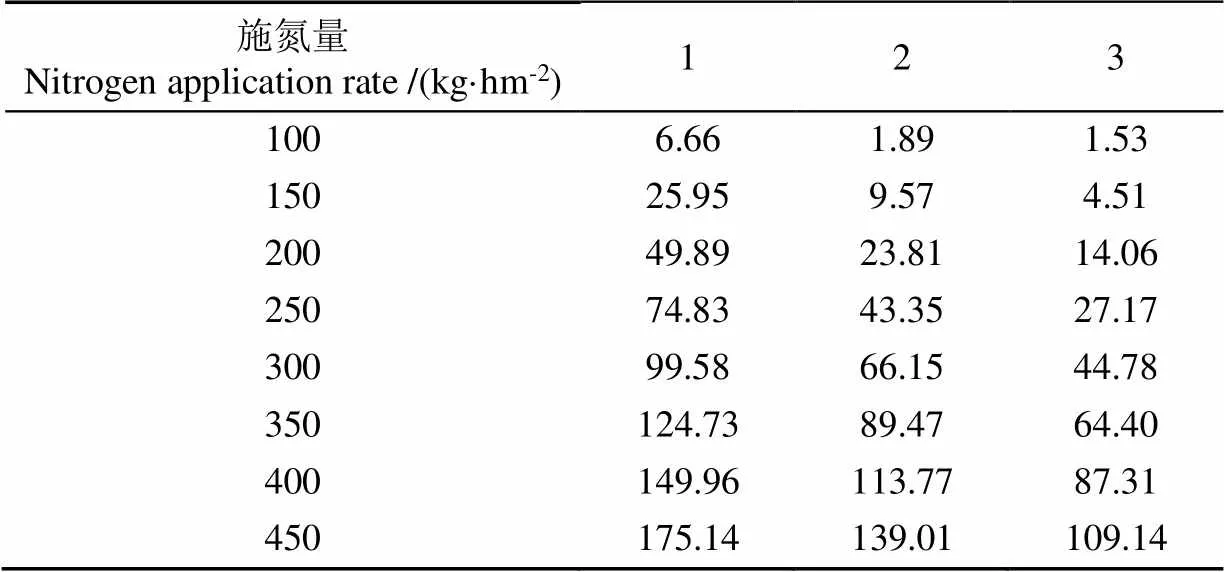
表6 不同施氮量及追肥次数下生长季硝态氮淋失量
注:表中追肥1次时硝态氮淋失量取5次不同追肥时期的平均值;追肥2次时硝态氮淋失量取3次不同追肥组合的平均值。
Note: In the table, the leaching of nitrate nitrogen during one topdressing was the average value of five different topdressing periods. The leaching of nitrate nitrogen during two topdressing was the average value of three different topdressing periods.
3 讨 论
3.1 不同施氮量对作物生长情况的影响
氮肥对作物生长至关重要,适当的氮肥施用量可以促进作物根系的生长发育。然而,当氮肥施用量过多或过少时均不利于作物的生长[21]。当土壤氮浓度处于较高水平时不仅会抑制作物的生长,而且会加快作物根系衰老,不利于玉米产量的形成[32]。谢英荷等[33]研究发现,当施氮量超过150 kg/hm2时,继续增加施氮量玉米生长指标已无明显上升趋势;而当施氮量小于210 kg/hm2时,玉米产量随施氮量的增加呈上升趋势,当施氮量大于210 kg/hm2时玉米产量又有所下降。Zhang等[14]指出当施氮量小于180 kg/hm2时,随施氮量增加作物产量也逐渐增长,但当施氮量大于180 kg/hm2时,籽粒产量随施氮量增加逐渐下降,这与本研究结果类似。本研究发现,当施氮量在100~200 kg/hm2时,玉米产量随施氮量增加而增加,当施氮量超过200 kg/hm2时,玉米产量上涨幅度较小,甚至出现降低现象。此外,李仙岳等[21]研究发现,由于作物吸氮能力有限,在作物生长前期增加施氮量对作物吸氮量没有促进作用,相反,在作物生长后期增加施氮量时,作物吸氮量才有所增加。而当施氮量达某一值时,继续增加施氮量,对作物吸氮量无明显促进作用。本研究得到与之类似的结果。不同施氮量和追肥次数下,生育期植株吸氮量均随施氮量增加呈先增长后逐渐趋于稳定的趋势。当追肥1次且在苗期或成熟期追肥时,植株吸氮量较少,较其他生育期追肥时的植株吸氮量平均降低50.98%和55.37%。采用Logistic方程对不同管理方案下植株吸氮量和施氮量进行回归分析,再通过对方程进行二次求导,求得不同管理措施下植株吸氮量达最大值时所对应的施氮量(表5)。
3.2 不同管理措施对硝态氮淋失量、植株吸氮量和玉米产量的影响
在增加作物产量的同时,施用肥料也会引发一系列负面环境问题。目前农业面源污染已经成为世界许多农业领域的严重问题[34],而硝酸盐淋失是最普遍的面源污染之一,已在全球范围内被广泛证实[35]。此外,大量氮素流失不仅导致生态系统富营养化和水质退化[36-37],还会增加人类癌症、水体缺氧和生物多样性丧失的风险[38]。已有研究发现中国玉米的化学氮肥施用量平均为260 kg/hm2,几乎是大多数作物需氮量的2倍[39]。在中国北方14个县进行的一项调查显示,大约一半地区(28 万hm2)地下水中硝酸盐浓度超过11.3 mg/L(即世界卫生组织和欧洲饮用水中硝酸盐的限量)[9]。赵同科等[40]研究发现,通过对华北地区1139个地下水井硝酸盐浓度进行测定,约34.1%都超过了WHO标准。Ju等[41]在中国北方600个地下水实地调查发现,一些地区的浅层地下水硝酸盐浓度已经超过了274 mg/L,且随时间推移,地下水硝酸盐污染深度也在逐渐增加[42]。
本研究结果表明,硝态氮淋失量随施氮量增加不断增加[43],而随追肥次数增加,硝态氮淋失量呈逐渐降低趋势[14]。当追肥次数为2次和3次时,生长季硝态氮淋失量较追肥1次时平均减少41.96%、59.75%。此结果与周慧等[22]研究结果(硝态氮淋失量随施肥次数增加而增加)略有差异。原因可能是试验区土壤质地、降雨分布、灌水量、施肥方式以及施肥时间等不同有关。
为达到GB/T14848—1993《地下水质量标准》中规定的20 mg/L的人类健康标准,玉米生长季硝态氮淋失量应低于18.4 kg/hm2[14]。本研究中,生长季硝态氮淋失量满足标准的管理方案分别为追肥1次且施氮量为100 kg/hm2、追肥2次且施氮量在100~150 kg/hm2与追肥3次且施氮量在100~200 kg/hm2。而追肥1次且施氮量为100 kg/hm2与追肥2次施氮量在100~150 kg/hm2时,玉米产量较低,平均产量仅有5 414.93 kg/hm2,远远低于当地平均水平[44]。综合玉米产量、硝态氮淋失量和植株吸氮量,施氮量在165.50~200 kg/hm2之间且分别在拔节期、抽雄期和灌浆期追肥时,可以同时保证玉米一定产量和硝态氮淋失量在可接受范围。
本研究以玉米产量和硝态氮淋失量为目标来确定最佳施氮量范围,下一步研究应在此基础上考虑如何提高玉米的氮肥利用效率。
4 结 论
脱氮-分解作用模型(Denitrification-Decomposition Model,DNDC)可以较好地模拟内蒙古河套灌区不同施氮量对玉米产量及氮素吸收利用的影响,并通过不同情景模拟,确定临界施氮量及较优追肥方案。
1)DNDC模型对玉米产量、叶面积指数和硝态氮累积量的模拟结果较好,玉米产量、叶面积指数和收获时土壤0~20 cm土层土壤硝态氮累积量纳什效率系数与2均不小于0.75,标准均方根误差为9.26%~9.57%、13.49%~17.51%和19.84%~21.48%。
2)模型参数敏感性分析表明,施氮量(敏感性指数1.92、−0.89)和追肥次数(敏感性指数0.11、−0.85)对硝态氮淋失量和植株吸氮量的影响较大,玉米产量仅对施氮量(敏感性指数−0.48)敏感。过多施用氮肥不会促进植株吸氮量和产量的增加,反而会增加硝态氮淋失量造成环境污染。
3)通过对不同情景的模拟分析可知,为了实现玉米产量和可接受硝态氮淋失量,最佳施氮量范围应为165.50~200 kg/hm2且分别在玉米生长的拔节、抽雄、灌浆期进行追肥。
[1] Heffer P. Assessment of fertilizer use by crop at the global level 2006/07—2007/088[R]. Paris, France: International Fertilizer Industry Association, 2009: 8-11.
[2] 中华人民共和国国家统计局. 中国统计年鉴[M]. 北京:中国农业出版社,2016.
[3] 串丽敏,赵同科,安志装,等. 土壤硝态氮淋溶及氮素利用研究进展[J]. 中国农学通报,2010,26(11):200-205.
Chuan Limin, Zhao Tongke, An Zhizhuang, et al. Research advancement in nitrate leaching and nitrogen use in soils[J]. Chinese Agricultural Science Bulletin, 2010, 26(11): 200-205. (in Chinese with English Abstract)
[4] 章明清,陈防,林琼,等. 施肥对菜园土壤养分淋溶流失浓度的影响[J]. 植物营养与肥料学报,2008,14(2):291-299.
Zhang Mingqing, Chen Fang, Lin Qiong, et al. Effect of fertilization on the concentration of soil nutrient leaching loss in vegetable garden[J]. Plant Nutrition and Fertilizer Science, 2008, 14(2): 291-299. (in Chinese with English Abstract)
[5] Li C S, Farahbakhshazad N, Jaynes D B, et al. Modeling nitrate leaching with a biogeochemical model modified based on observations in a row-crop field in Iowa[J]. Ecological Modelling, 2006, 196(1): 116-130.
[6] Zhu A N, Zhang J B, Zhao B Z, et al. Water balance and nitrate leaching losses under intensive crop production with Ochric Aquic Cambosols in North China Plain[J]. Environment International, 2005, 31(6): 904-912.
[7] 秦雪超,潘君廷,郭树芳,等. 化肥减量替代对华北平原小麦-玉米轮作产量及氮流失影响[J]. 农业环境科学学报,2020,39(7):1558-1567.
Qin Xuechao, Pan Junting, Guo Shufang, et al. Effects of chemical fertilizer reduction combined with biogas fertilizer on crop yield of wheat-maize rotation and soil nitrogen loss in North China Plain[J]. Journal of Agro-Environment Science, 2020, 39(7): 1558-1567. (in Chinese with English Abstract)
[8] 周慧,史海滨,张文聪,等. 有机无机肥配施对盐渍化土壤微生物量和呼吸的影响[J]. 农业工程学报,2021,37(15):86-95.
Zhou Hui, Shi Haibin, Zhang Wencong, et al. Effects of the combined application of organic and inorganic fertilizers on soil microbial biomass and soil respiration in saline soil[J]. Transactions of the Chinese Society for Agricultural Machinery, 2021, 37(15): 86-95. (in Chinese with English Abstract)
[9] Zhang W L, Tian Z X, Zhang N, et al. Nitrate pollution of groundwater in northern China[J]. Agriculture, Ecosystems and Environment, 1996, 59(3): 223-231.
[10] 谷少委,高剑民,邓忠,等. 畦灌与施肥时机对土壤硝态氮分布和冬小麦产量的影响[J]. 农业工程学报,2020,36(9):134-142.
Gu Shaowei, Gao Jianmin, Deng Zhong, et al. Effects of border irrigation and fertilization timing on soil nitrate nitrogen distribution and winter wheat yield[J]. Transactions of the Chinese Society of Agricultural Engineering (Transactions of the CSAE), 2020, 36(9): 134-142. (in Chinese with English abstract)
[11] 张万锋,杨树青,刘鹏,等. 秸秆覆盖方式和施氮量对河套灌区夏玉米氮利用及产量影响[J].农业工程学报,2020,36(21):71-79.
Zhang Wanfeng, Yang Shuqing, Liu Peng, et al. Effects of stover mulching combined with N application on N use efficiency and yield of summer maize in Hetao Irrigated District[J]. Transactions of the Chinese Society of Agricultural Engineering (Transactions of the CSAE), 2020, 36(21): 71-79. (in Chinese with English abstract)
[12] 张璐,黄晶,高菊生,等. 长期绿肥与氮肥减量配施对水稻产量和土壤养分含量的影响[J]. 农业工程学报,2020,36(5):106-112.
Zhang Lu, Huang Jing, Gao Jusheng, et al. Effects of long-term green manure and reducing nitrogen applications on rice yield and soil nutrient content[J]. Transactions of the Chinese Society of Agricultural Engineering (Transactions of the CSAE), 2020, 36(5): 106-112. (in Chinese with English abstract)
[13] 任静,刘小勇,韩富军,等. 施氮水平对旱塬覆沙苹果园土壤酶活性及果实品质的影响[J]. 农业工程学报,2019,35(8):206-213.
Ren Jing, Liu Xiaoyong, Han Fujun, et al. Effects of nitrogen fertilizer levels on soil enzyme activity and fruit quality of sand-covered apple orchard in Loess Plateau of Eastern Gansu[J]. Transactions of the Chinese Society of Agricultural Engineering (Transactions of the CSAE), 2019, 35(8): 206-213. (in Chinese with English abstract)
[14] Zhang Y T, Wang H Y, Liu S, et al. Identifying critical nitrogen application rate for maize yield and nitrate leaching in a Haplic Luvisol soil using the DNDC model[J]. Science of the Total Environment, 2015, 514: 388-398.
[15] Li C S, Frolking S, Frolking T A. A model of nitrous oxide evolution from soil driven by rainfall events: 1. Model structure and sensitivity[J]. Journal of Geophysical Research: Atmospheres, 1992, 97(D9): 9759-9776.
[16] Li C S, Frolking S, Frolking T A. A model of nitrous oxide evolution from soil driven by rainfall events: 2. Model applications[J]. Journal of Geophysical Research: Atmospheres, 1992, 97(D9): 9777-9783.
[17] Li C S. Modeling trace gas emissions from agricultural ecosystems[J]. Nutrient Cycling in Agroecosystems, 2000, 58(1): 259-276.
[18] 刘宁,韩娟,刘璐璐,等. 应用DNDC模型模拟沟垄集雨种植对陕西省玉米产量的影响[J]. 西北农业学报,2016,25(5):691-701.
Liu Ning, Han Juan, Liu Lulu, et al. Effects of simulation of rainfall harvesting with ridge and furrow system on maize yield in Shaanxi Province by use of DNDC model[J]. Acta Agriculturae Boreali-occidentalis Sinic, 2016, 25(5): 691-701. (in Chinese with English Abstract)
[19] 朱波,周明华,况福虹,等. 紫色土坡耕地氮素淋失通量的实测与模拟[J]. 中国生态农业学报,2013,21(1):102-109.
Zhu Bo, Zhou Minghua, Kuang Fuhong, et al. Measurement and simulation of nitrogen leaching loss in hillslope cropland of purple soil[J]. Chinese Journal of Eco-Agriculture, 2013, 21(1): 102-109. (in Chinese with English Abstract)
[20] Li H, Wang L G, Qiu J J, et al. Calibration of DNDC model for nitrate leaching from an intensively cultivated region of Northern China[J]. Geoderma, 2014, 223: 108-118.
[21] 李仙岳,冷旭,张景俊,等. 北方干旱区降解膜覆盖农田玉米生长和氮素利用模拟及优化[J]. 农业工程学报,2020,36(5):113-121.
Li Xianyue, Leng Xu, Zhang Jingjun, et al. Simulation and optimization of maize growth and nitrogen utilization under degradation film mulching in arid areas of North China[J]. Transactions of the Chinese Society of Agricultural Engineering (Transactions of the CSAE), 2020, 36(5): 113-121. (in Chinese with English abstract)
[22] 周慧,史海滨,张文聪,等. 有机无机氮配施对玉米产量和硝态氮淋失的影响[J]. 农业机械学报,2021,52(9):291-301,249.
Zhou Hui, Shi Haibin, Zhang Wencong, et al. Evaluation of organic-inorganic nitrogen application on maize yield and nitrogen leaching by DNDC Model[J]. Transactions of the Chinese Society for Agricultural Machinery, 2021, 52(9): 291-301, 249. (in Chinese with English Abstract)
[23] Giltrap D L, Li C S, Saggar S. DNDC: A process-based model of greenhouse gas fluxes from agricultural soils[J]. Agriculture, Ecosystems and Environment, 2010, 136: 292-300.
[24] Dutta B, Smith W N, Grant B B, et al. Model development in DNDC for the prediction of evapotranspiration and water use in temperate field cropping systems[J]. Environmental Modelling and Software, 2016, 80: 9-25.
[25] Lv F L, Song J S, Giltrap D, et al. Crop yield and N2O emission affected by long-term organic manure substitution fertilizer under winter wheat-summer maize cropping system[J]. Science of the Total Environment, 2020, 732: 9684-9697.
[26] 张富仓,严富来,范兴科,等. 滴灌施肥水平对宁夏春玉米产量和水肥利用效率的影响[J]. 农业工程学报,2018,34(22):111-120.
Zhang Fucang, Yan Fulai, Fan Xingke, et al. Effects of irrigation and fertilization levels on grain yield and water fertilizer use efficiency of drip fertigation spring maize in Ningxia[J]. Transactions of the Chinese Society of Agricultural Engineering (Transactions of the CSAE), 2018, 34(22): 111-120. (in Chinese with English abstract)
[27] 孙占祥,邹晓锦,张鑫,等. 施氮量对玉米产量和氮素利用效率及土壤硝态氮累积的影响[J]. 玉米科学,2011,19(5):119-123.
Sun Zhanxiang, Zou Xiaojin, Zhang Xin, et al. Effects of maize yield and N application on N utilization and content of soil nitrate[J]. Journal of Maize Sciences, 2011, 19(5): 119-123. (in Chinese with English Abstract)
[28] Deng Q, Hui D F, Wang J M, et al. Assessing the impacts of tillage and fertilization management on nitrous oxide emissions in a cornfield using the DNDC model[J]. Journal of Geophysical Research: Biogeosciences, 2016, 121(2): 337-349.
[29] 陈超飞,柳双环,郭大辛,等. 基于AquaCrop模型的夏玉米生长模拟及灌溉制度优化[J]. 干旱地区农业研究,2019,37(3):72-82.
Chen Chaofei, Liu Shuanghuan, Guo Daxin, et al. Growth simulation and optimization of irrigation scheme for summer maize using AquaCrop model[J]. Agricultural Research in the Arid Areas, 2019, 37(3): 72-82. (in Chinese with English abstract)
[30] Deng J, Zhu B, Zhou Z X, et al. Modeling nitrogen loadings from agricultural soils in southwest China with modified DNDC[J]. Journal of Geophysical Research, 2011, 116: G02020.
[31] He J Q, Dukes M D, Hochmuth G J, et al. Identifying irrigation and nitrogen best management practices for sweet corn production on sandy soils using CERES-Maize model[J]. Agricultural Water Management, 2012, 109: 61-70.
[32] 杨华,祁生林,彭云峰. 玉米优化施氮高产高效生理机制[J]. 农业工程,2016,6(2):127-129, 109.
Yang Hua, Qi Shenglin, Peng Yunfeng. Mechanisms of high maize yield and nitrogen use efficiency under optimized nitrogen management[J]. Agricultural Engineering, 2016(2): 127-129, 109. (in Chinese with English Abstract)
[33] 谢英荷,栗丽,洪坚平,等. 施氮与灌水对夏玉米产量和水氮利用的影响[J]. 植物营养与肥料学报,2012,18(6):1354-1361.
Xie Yinghe, Li Li, Hong Jianping, et al. Effects of nitrogen application and irrigation on grain yield, water and nitrogen utilizations of summer maize[J]. Plant Nutrition and Fertilizer Science, 2012, 18(6): 1354-1361. (in Chinese with English Abstract)
[34] He S J, Lu J. Contribution of baseflow nitrate export to non-point source pollution[J]. Science China Earth Sciences, 2016, 59(10): 1912-1929.
[35] Wang Z H, Li S X. Nitrate N loss by leaching and surface runoff in agricultural land: A global issue (a review)[J]. Advances in Agronomy, 2019, 156: 159-217.
[36] Zhou M H, Zhu B, Butterbach-Bahl K, et al. Nitrate leaching, direct and indirect nitrous oxide fluxes from sloping cropland in the purple soil area, southwestern China[J]. Environmental Pollution, 2012, 162(5): 361-368.
[37] Sebilo M, Mayer B, Nicolardot B, et al. Long-term fate of nitrate fertilizer in agricultural soils[J]. Proceedings of the National Academy of Sciences of the United States of America, 2013, 110(45): 18185-18189.
[38] Sybil S. Nitrogen cycle: Out of reach[J]. Nature, 2008, 452(7184): 162-163.
[39] Chen X P, Cui Z L, Vitousek P M, et al. Integrated soil-crop system management for food security[J]. Proceedings of the National Academy of Sciences of the United States America, 2011, 108: 6399-6404.
[40] 赵同科,张成军,杜连凤,等. 环渤海七省(市)地下水硝酸盐含量调查[J]. 农业环境科学学报,2007,26(2):779-783.
Zhao Tongke, Zhang Chengjun, Du Lianfeng, et al. Investigation on nitrate concentration in groundwater in seven provinces (city) surrounding the Bo-Hai Sea[J]. Journal of Agro-Environment Science, 2007, 26(2): 779-783. (in Chinese with English Abstract)
[41] Ju X T, Kou C L, Zhang F S, et al. Nitrogen balance and groundwater nitrate contamination: Comparison among three intensive cropping systems on the North China Plain[J]. Environmental Pollution, 2005, 143(1): 117-125.
[42] Liu G D, Wu W L, Zhang J. Regional differentiation of non-point source pollution of agriculture-derived nitrate nitrogen in groundwater in northern China[J]. Agriculture, Ecosystems and Environment, 2005, 107: 211-220.
[43] 张春霞,文宏达,刘宏斌,等. 优化施肥对大棚番茄氮素利用和氮素淋溶的影响[J]. 植物营养与肥料学报,2013,19(5):1139-1145.
Zhang Chunxia, Wen Hongda, Liu Hongbin, et al. Effect of optimum fertilization on nitrogen use efficiency and nitrate leaching in the greenhouses[J]. Journal of Plant Nutrition and Fertilizers, 2013, 19(5): 1139-1145. (in Chinese with English Abstract)
[44] 李聪聪. 盐渍化灌区维持作物稳定生长水氮耦合及其阈值研究[D]. 呼和浩特:内蒙古农业大学,2020.
Li Congcong. Study on the Coupling of Water and Nitrogen and Its Threshold for Maintaining Stable Crop Growth in Salinized Irrigated Area[D]. Hohhot: Inner Mongolia Agricultural University, 2020. (in Chinese with English Abstract)
Simulation of the threshold of maize nitrogen application using a DNDC model in salinized irrigation areas
Dai Jialu1, Li Ruiping1※, Li Congcong1, Lu Yaoze2, Hua Zhimin3
(1.010018,; 2.015000,; 3.010020,)
This study aims to determine the suitable nitrogen application rate for agricultural production and environmental protection in salinized irrigation areas. A two-year field experiment was carried out in the Hetao Irrigation District of Inner Mongolia in Western China. A Denitrification-Decomposition (DNDC) model was selected to simulate the key factors, including the amount of nitrate leaching loss, the amount of plant nitrogen uptake, and the threshold of maize nitrogen application rate. The results showed that: 1) The DNDC model accurately simulated the maize yield and nitrogen utilization. A better agreement between the measured and simulated data was achieved on the maize yield, leaf area index (LAI) and soil nitrate-nitrogen accumulation in the 0-20 cm soil layer, where the model Nash-Sutcliffe efficiency (E) and the coefficient of determination (2) were all greater than 0.75, the normalized root mean square error (NRMSE) was 9.26%-9.57%, 13.49%-17.51%, and 19.84%-21.48%, respectively. 2) A sensitivity analysis of the model parameters showed that the nitrogen application rate (the sensitivity index of 1.92 and -0.89) and topdressing times (the sensitivity index of 0.11, and -0.85) presented significant effects on the amount of nitrate leaching loss and plant nitrogen uptake. However, the tillage depth (the sensitivity index of 0.03, and 0.09) and irrigation amount (the sensitivity index of -0.02, and -0.01) behaved little effect on the amount of nitrate leaching loss and plant nitrogen uptake. Whereas, the excessive application of nitrogen rate cannot promote the amount of plant nitrogen uptake and yield, but lead to the amount of nitrate leaching and even environmental pollution. 3) The amount of plant nitrogen uptake and maize yield increased firstly and then gradually stabilized, with the increase of nitrogen application rate. In addition, the amount of plant nitrogen uptake during the growth period increased by 167.18% and 31.27%, when the number of topdressing was three times, compared with one and two times. 4) Once the number of topdressing was the same, the nitrate leaching loss increased with the increase of nitrogen application rate. However, the leaching loss of nitrate decreased gradually with the increase of topdressing times, when the amount of nitrogen rate was constant. The nitrate leaching loss in the growing season decreased by 41.96% and 59.75%, when the number of topdressing was two or three times, compared with the single. As such, the optimal fertilization was 165.50-200 kg/hm2nitrogen application rate, and top fertilization at the jointing, tasseling, and filling stages, considering the yield, the nitrate leaching loss, and the nitrogen rate applied with the maximum amount of plant nitrogen uptake. The finding can provide technical support to reduce the groundwater pollution and resource wastes in Hetao Irrigation District.
nitrogen; leaching; irrigation; maize; yield; amount of plant nitrogen uptake; DNDC model
2021-07-26
2021-10-10
国家自然科学基金(51839006,52069021)
戴嘉璐,研究方向为灌溉排水理论与新技术。Email:1529231858@qq.com
李瑞平,博士,教授,博士生导师,研究方向为节水灌溉与农业水利遥感信息技术。Email:nmglrp@163.com
10.11975/j.issn.1002-6819.2021.24.015
S158.5
A
1002-6819(2021)-24-0131-10
戴嘉璐,李瑞平,李聪聪,等. 盐渍化灌区玉米施氮量阈值DNDC模型模拟[J]. 农业工程学报,2021,37(24):131-140. doi:10.11975/j.issn.1002-6819.2021.24.015 http://www.tcsae.org
Dai Jialu, Li Ruiping, Li Congcong, et al. Simulation of the threshold of maize nitrogen application using a DNDC model in salinized irrigation areas[J]. Transactions of the Chinese Society of Agricultural Engineering (Transactions of the CSAE), 2021, 37(24): 131-140. (in Chinese with English abstract) doi:10.11975/j.issn.1002-6819.2021.24.015 http://www.tcsae.org
